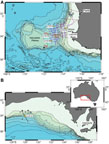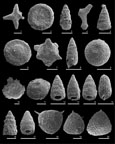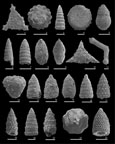Hobbs, R.W., Huber, B.T., Bogus, K.A., and the Expedition 369 Scientists
Proceedings of the International Ocean Discovery Program Volume 369
publications.iodp.org
https://doi.org/10.14379/iodp.proc.369.203.2021
Data report: radiolarians from the latest Cenomanian and Turonian, Holes U1512A and U1516C, IODP Expedition 3691
Jochen Erbacher2
Keywords: International Ocean Discovery Program, IODP, JOIDES Resolution, Expedition 369, Australia Cretaceous Climate and Tectonics, Hole U1512A, Hole U1516C, Mentelle Basin, Great Australian Bight
MS 369-203: Received 24 August 2020 · Accepted 5 January 2021 · Published 30 April 2021
Abstract
A total of 47 samples from the Albian to Turonian at three sites from International Ocean Discovery Program (IODP) Expedition 369 were investigated for radiolarian faunas. With a few exceptions, the preservation of radiolarian tests did not allow for a taxonomically sophisticated and proper determination. Consequently, radiolarian assemblages from only three samples from the uppermost Cenomanian in Hole U1516C, the lower Turonian in Hole U1516C, and the upper Turonian in Hole U1512A are described and illustrated here. The three faunas described include faunal elements reported from time equivalent successions in the Tethys as well as the western Pacific.
Introduction
International Ocean Discovery Program (IODP) Expedition 369 recovered sediments from the Great Australian Bight and Mentelle Basin in the southeast Indian Ocean (Figure F1). One of the main reasons for drilling the Expedition 369 sites was their high paleolatitude (60°–62°S) position, which allowed the sampling of high-latitude successions that are important for a reconstruction of the dynamics of the Cretaceous greenhouse climate system (Huber et al., 2019). Cenomanian to Turonian radiolarians from this part of the Cretaceous world have only been described in a single study so far that documented some specimens from Deep Sea Drilling Project (DSDP) Site 258 (Riedel and Sanfilippo, 1974). For this reason, documentation of new radiolarian records from Expedition 369 sediments is warranted. Note that because of their moderate to poor preservation, the three assemblages described here do not represent the entire taxonomic spectrum of radiolarians from this stratigraphic interval and area.
Material and methods
All samples were crushed into small pieces (approximately 1 cm in diameter), dried, and gently disaggregated using a 90% water and 10% hydrochloric acid solution. After soaking and reacting, the samples were washed with warm water over a 40 µm mesh sieve and dried at 50°C. The fraction >40 µm was then dry-sieved into fractions >125 µm and >63 µm. From each fraction, radiolarians were picked in slides. Scanning electron microscope (SEM) images were acquired at the laboratories of the Federal Institute for Geosciences and Natural Resources (BGR) in Hannover (Germany) using an FEI Sirion 200.
Results
The estimated abundance and preservation of the samples investigated is documented in Table T1. With very few exceptions, radiolarians are rare in the Turonian in Hole U1512A. The abundance, preservation, and species diversity increase upsection. No radiolarians were found in samples from Hole U1513A. The residue, however, consists of siliceous chalks and some faint ghost structures of organisms. The latter might have been radiolarian tests leaving the impression that the absence of radiolarians is not caused by ecological but diagenetic reasons. The diagenetic overprint of the samples investigated from the Cenomanian/Turonian Boundary interval in Hole U1516C is less severe, resulting in comparably well-preserved faunas. The number of species in each sample listed here correlates with the preservation of faunas; the higher the species diversity, the better the preservation:
- Sample 369-U1512A-44R-6, 70–74 cm: Crucella irwini, Dactyliosphaera silviae, Dactyliosphaera maxima, Diacanthocapsa ovoidea, Dictyomitra formosa, Hexapyramis pantanellii, Novixitus mclaughlini, Pessagnobrachia sp., and Stichomitra stocki.
- Sample 369-U1516C-28R-4, 26–30 cm: Alievum praegallowayi, Cavaspongia tricornis, Conocaryomma universa, Dactyliosphaera maxima, Dictyomitra formosa, Diacanthocapsa ovoidea, Dictyomitra montisserei, Dictyomitra multicostata, Distylocapsa squama, Distylocapsa veneta, Paronaella communis, Pessagnobrachia clavata, Pseudoaulophacus sp. aff. vielseitigus, Pyramispongia glascockensis, Sciadiocapsa euganea, Stichomitra stocki, Stichomitra conicus, Xitus clava, and Xitus spicularius.
- Sample 369-U1516C-33R-4, 56–60 cm: Dictyomitra montisserei, Holocryptocanium barbui, Novixitus mclaughlini, Orbiculiforma aff. O. multangula, Patellula verteroensis, Stichomitra stocki, Thanarla conica, and Thanarla pulchra.
Stratigraphic implications
The reported stratigraphic ranges of some of the radiolarian species identified allow for summary age estimates of the two samples from Hole U1516C. A. praegallowayi, D. squama, P. clavata, S. conicus, and P. vielseitigus described here from Sample 369-U1516C-28R-4, 26–30 cm, are species typical in younger Late Cretaceous strata. They have not been reported from successions older than early Turonian in age. In contrast, H. barbui and T. pulchra, which are both present in Sample 33R-4, 56–60 cm, have not been reported from strata younger than latest Cenomanian in age. This confirms the presence of the Cenomanian–Turonian transition in Hole U1516C. Another species that hasn’t been described in sediments younger than latest Cenomanian in age is N. mclaughlini. In this study, however, it is documented in the late Turonian in Hole U1512A with a little doubt because the preservation is rather poor.
Acknowledgments
This research used samples and/or data provided by the International Ocean Discovery Program (IODP). I would like to thank IODP for making the samples available. Thanks also to Brian Huber and Maria Rose Petrizzo for making me aware of the presence of radiolarians in the Cenomanian and Turonian at the IODP Expedition 369 sites and thus making me enter a kind of time warp resulting in my first (and probably last) involvement in radiolarian research in 20 y. Gabriele Grützner and Sabine Stäger, both at BGR, are thanked for SEM imaging, sample preparation, and production of plates. Finally, I thank Chris Hollis for his constructive review, which greatly improved this manuscript.
References
Asis, J., and Jasin, B., 2012. Aptian to Turonian radiolaria from the Darvey Bal ophiolite complex, Kunak, Sabah. Buletin Persatuan Geologi Malaysia, 58:89–96. https://doi.org/10.7186/bgsm58201213
Bragina, L.G., 2012. Radiolarian biostratigraphy of the Perapedhi formation (Cyprus): implications for the geological evolution of the Troodos ophiolite. Bulletin de la Société Géologique de France, 183(4):343–348. https://doi.org/10.2113/gssgfbull.183.4.343
Ellis, G., 1993. Late Aptian-early Albian radiolaria of the Windalia radiolarite (type section), Carnarvon Basin, western Australia. Eclogae Geologicae Helvetiae, 86:943–995.
Erbacher, J., 1994. Entwicklung und Paläoozeanographie mittelkretazischer Radiolarien der westlichen Tethys (Italien) und des Nordatlantiks [Ph.D dissertation]. University of Tübingen, Germany.
Erbacher, J., 1998. Mid-Cretaceous radiolarians from the eastern equatorial Atlantic and their paleoceanography. In Mascle, J., Lohmann, G. and Moullade, M. (Eds.), Proceedings of the Ocean Drilling Program, Scientific Results, 159: College Station, TX (Ocean Drilling Program), 363–373. https://doi.org/10.2973/odp.proc.sr.159.037.1998
Hashimoto, H., Ishida, K., Yamasaki, T., Tsujino, Y., and Kozai, T., 2015. Revised radiolarian zonation of the Upper Cretaceous Izumi inter-arc basin (SW Japan). Revue de Micropaléontologie, 58(1):29–50. https://doi.org/10.1016/j.revmic.2015.01.001
Huber, B.T., Hobbs, R.W., Bogus, K.A., Batenburg, S.J., Brumsack, H.-J., Guerra, R.d.M., Edgar, K.M., Edvardsen, T., Garcia Tejada, M.L., Harry, D.L., Hasegawa, T., Haynes, S.J., Tao, J., Jones, M.M., Kuroda, J., Lee, E.Y., Yongxiang, L., MacLeod, K.G., Maritati, A., Martinez, M., O'Connor, L.K., Petrizzo, M.R., Quan, T.M., Richter, C., Riquier, L., Tagliaro, G.T., Wainman, C.C., Watkins, D.K., White, L.T., Wolfgring, E., and Zhaokai, X., 2019. Expedition 369 summary. In Hobbs, R.W., Huber, B.T., Bogus, K.A. and the Expedition 369 Scientists (Eds.), Australia Cretaceous climate and tectonics, 369: College Station, TX (International Ocean Discovery Program). https://doi.org/10.14379/iodp.proc.369.101.2019
Koyasu, H., Nishi, H., Takashima, R., and Suzuki, N., 2019. Cretaceous radiolarian biostratigraphy in the Yezo group, Hokkaido, northeast Japan. Newsletters on Stratigraphy, 52(3):297–319. https://doi.org/10.1127/nos/2018/0357
O’Dogherty, L., 1994. Biochronology and Paleontology of Mid-Cretaceous Radiolarians from Northern Apennines (Italy) and Betic Cordillera (Spain). Mémoires de Géologie (Lausanne), 21.
Pessagno, E.A., Jr., 1971. Jurassic and Cretaceous Hagiastridae from the Blake-Bahama Basin (Site 5A, JOIDES Leg I) and the Great Valley sequence, California Coast Ranges. Bulletin of American Paleontology, 60(264).
Pessagno, E.A., 1976. Radiolarian Zonation and Stratigraphy of the Upper Cretaceous Portion of the Great Valley Sequence, California Coast Ranges: New York (Micropaleontology Press).
Pessagno, E.A., Jr., 1977. Lower Cretaceous radiolarian biostratigraphy of the Great Valley sequence and Franciscan complex, California Coast Ranges. Special Publication - Cushman Foundation for Foraminiferal Research, 15.
Riedel, W.R., and Sanfilippo, A., 1974. Radiolaria from the southern Indian Ocean, DSDP Leg 26. In Davies, T.A., Luyendyk, P.B. et al. (Eds.), Initial Reports of the Deep Sea Drilling Project, 26, 771–813. https://doi.org/10.2973/dsdp.proc.26.133.1974
Thurow, J., 1988. Cretaceous radiolarians of the North Atlantic Ocean: ODP Leg 103 (Sites 638, 640, and 641) and DSDP legs 93 (Site 603) and 47B (Site 398). In Boillot, G., Winterer, E.L. et al. (Eds.), Proceedings of the Ocean Drilling Program, Scientific Results, 103: College Station, TX (Ocean Drilling Program), 379–418. https://doi.org/10.2973/odp.proc.sr.103.148.1988
Urquhart, E., 1995. Pseudoaulophacid radiolarians from the Campanian of Cyprus. Senckenbergiana Lethaea, 75:23–31.
Vishnevskaya, V.S., and Kopaevich, L.F., 2020. Microfossil assemblages as key to reconstruct sea-level fluctuations, cooling episodes and palaeogeography: the Albian to Maastrichtian of Boreal and Peri-Tethyan Russia. Geological Society Special Publication, 498:165–187. https://doi.org/10.1144/sp498-2018-138
Appendix
Taxonomic notes
These brief notes explain the taxonomic concept applied in this report. Younger, post-mid-nineties studies are cited if they are based on western Pacific locations (i.e., in relative proximity to the Expedition 369 sites).
Alievum praegallowayi Pessagno
(Plate P1, figures 18–20)
Alievum praegallowayi, Bragina, 2012, pl. 1, fig. 4; Koyasu et al., 2019, pl. 3, fig. 15.
Remarks: This species has been reported from the Tethys, central Atlantic, western Pacific, and eastern Pacific.
Cavaspongia tricornis O’Dogherty
(Plate P1, figure 1)
Cavaspongia tricornis, O’Dogherty, 1994, p. 313–314, pl. 57, figs. 24–28.
Pseudoaulophacus sculptus (Squinabol), Asis and Jasin, 2012, pl. 3, fig. 5.
Remarks: This species has been reported from the Tethys and Malaysia.
Crucella messinae Pessagno
(Plate P1, figure 1)
Crucella messinae, Pessagno, 1971, p. 56, pl. 6, figs. 1–3; Ellis, 1993, p. 960, pl. 2, figs. 1–4; O’Dogherty, 1994, p. 368, pl. 72, figs. 21–24, pl. 71, figs. 1–6; Erbacher, 1998, p. 369, pl. 2, fig. 26; Asis and Jasin, 2012, pl. 3, fig. 19.
Remarks: This species has been reported from the Tethys, central Atlantic, eastern Pacific, Malaysia, and Australia.
Conocaryomma universa (Pessagno)
(Plate P2, figure 2)
Conocaryomma universa, Erbacher, 1994, p. 95, pl. 17, fig. 10.
Remarks: This species has been reported from the Tethys, central Atlantic, western Pacific, and eastern Pacific.
Dactyliosphaera maxima (Pessagno)
(Plate P1, figure 2; Plate P2, figure 4)
Orbiculiforma maxima, Pessagno, 1976, pp. 34–35, pl. 1, figs. 14, 16; Erbacher, 1998, p. 370, pl. 1, fig. 25.
Dactyliosphaera maxima (Pessagno), O’Dogherty, 1994, pp. 338–339, pl. 63, figs. 5–8; Asis and Jasin, 2012, pl. 3, fig. 14.
Remarks: This species has been reported from the Tethys, central Atlantic, Malaysia, and eastern Pacific.
Dactyliosphaera silviae
(Plate P1, figure 6)
Pseudoaulophacus ? sp. D, Thurow, 1988, p. 404, pl. 5, fig. 14; Erbacher, 1994, p. 109, pl. 12, fig. 13, pl. 16, fig. 14.
Dactyliosphaera silviae Squinabol, O’Dogherty, 1994, p. 341, pl. 63, figs. 22–26; Erbacher, 1998, p. 370, pl. 1, fig. 27.
Remarks: This species has been reported from the Tethys, central Atlantic, and eastern Pacific.
Diacanthocapsa ovoidea Dumitrica
(Plate P2, figure 5)
Diacanthocapsa ovoidea, O’Dogherty, 1994, p. 220–221, pl. 37, figs. 1–6; Hashimoto et al., 2015.
Remarks: This species has been reported from the Tethys and western Pacific.
Dictyomitra formosa Squinabol
(Plate P2, figure 3)
Dictyomitra formosa, Thurow, 1988, p. 400, pl. 1, fig. 25; O’Dogherty, 1994, p. 80–81, pl. 4, figs. 8–12; Asis and Jasin, 2012, pl. 1, fig. 4; Hashimoto et al., 2015, pl. 2, fig. 2; Koyasu et al., 2019, pl. 3, fig. 7.
Remarks: This species has been reported from the Tethys, central Atlantic, western Pacific, Malaysia, and eastern Pacific.
Dictyomitra montisserei (Squinabol)
(Plate P1, figure 8; Plate P2, figures 6, 7)
Archaeodictyomitra simplex, Pessagno, Thurow, 1988, p. 398, pl. 3, fig. 9; Erbacher, 1998, p. 368, pl. 1, fig. 11; Koyasu et al., 2019, pl. 2, fig. 9.
Archaeodictyomitra sliteri, Ellis, 1993, pl. 5, fig. 15.
Dictyomitra montisserei (Squinabol), O’Dogherty, 1994, p. 77, pl. 3, figs. 1–29.
Remarks: This species has been reported from the Tethys, central Atlantic, western Pacific, eastern Pacific, and Australia.
Distylocapsa squama O’Dogherty
(Plate P2, figure 8)
Distylocapsa squama, O’Dogherty, 1994, p. 189, pl. 28, figs. 16–21.
Remarks: This species has been reported from the Tethys.
Distylocapsa veneta (Squinabol)
(Plate P2, figure 9)
Distylocapsa veneta, O’Dogherty, 1994, p. 189, pl. 28, figs. 10–15.
Remarks: This species has been reported from the Tethys and western Pacific.
Hexapyramis pantanellii Squinabol
(Plate P1, figure 7)
Hexapyramis pantanellii, O’Dogherty, 1994, p. 283, pl. 50, figs. 3–7; Erbacher, 1994, p. 101, pl. 5, figs. 2–3.
Remarks: This species has been reported from the Tethys and central Atlantic.
Holocryptocanium barbui Dumitrica
(Plate P1, figure 9)
Holocryptocanium barbui, Ellis, 1993, p. 963, pl. 4, fig. 24; Erbacher, 1994, p. 101, pl. 5, fig. 8, pl. 13, fig. 11; Koyasu et al., 2019, pl. 1, fig. 18.
Remarks: This species has been reported from the Tethys, central Atlantic, western Pacific, and Australia.
Novixitus mclaughlini Pessagno
(Plate P1, figures 3, 16)
Novixitus mclaughlini, Pessagno, 1977, p. 54, pl. 9, fig. 17; Erbacher, 1994, p. 104, pl. 6, fig. 4, pl. 7, figs. 13–14; Erbacher, 1998, p. 370, pl. 2, fig. 6; Koyasu et al., 2019, pl. 2, fig. 4.
Xitus mclaughlini, O’Dogherty, 1994, p. 130–131, pl. 12, figs. 14–21; Asis and Jasin, 2012, pl. 1, fig. 14.
Remarks: This species has been reported from the Tethys, central Atlantic, western Pacific, Malaysia, and eastern Pacific.
Orbiculiforma aff. O. multangula Pessagno
(Plate P1, figure 10)
Orbiculiforma multangular, Pessagno, Vishnevskaya and Kopaevich, 2020, p. 172, fig. 6.
Remarks: This species resembles O. multangula but the preservation is too poor to clearly determine it as such. O. multangula has been described from the Aptian and Albian of the central Atlantic, Tethys, and eastern Pacific.
Paronaella communis (Squinabol)
(Plate P2, figure 10)
Paronaella communis, O’Dogherty, 1994, pp. 353–354, pl. 66, figs. 9–16.
Remarks: This species has been reported from the Tethys and western Pacific.
Patellula verteroensis (Pessagno)
(Plate P1, figure 11)
Patellula verteroensis, Erbacher, 1994, p. 106, pl. 19, figs. 1–2; O’Dogherty, 1994, pp. 328–329, pl. 60, figs. 25–26; Erbacher, 1998, p. 370, pl. 1, fig. 24.
Remarks: This species has been reported from the Tethys, central Atlantic, western Pacific, and eastern Pacific.
Pessagnobrachia clavata (Squinabol)
(Plate P2, figure 11)
Paronaella sp. EJ1, Erbacher, 1994, p. 106, pl. 17, figs. 16–17.
Pessagnobrachia clavata, O’Dogherty, 1994, pp. 362–363, pl. 68, figs. 21–26.
Remarks: This species has been reported from the western Tethys.
Pseudoaulophacus sp. aff. vielseitigus
(Plate P2, figure 21)
Remarks: Pseudoaulophacids are a very diverse group as has been shown by Urquhart (1995). The specimen illustrated herein differs from P. vielseitigus (Empson-Morin) by having 8 instead of 5 to 7 sides.
Pyramispongia glascockensis Pessagno
(Plate P2, figure 12)
Pyramispongia glascockensis, O’Dogherty, 1994, pp. 184–185, pl. 27, figs. 9–13.
Remarks: This species has been reported from the Tethys, central Atlantic, western Pacific, and eastern Pacific.
Sciadiocapsa euganea Squinabol
Sciadiocapsa euganea, O’Dogherty, 1994, p. 232–233, pl. 39, figs. 17–21.
Remarks: This species has been reported from the Tethys and eastern Pacific.
Stichomitra conicus (Nakaseko and Nishimura)
(Plate P2, figures 15, 22)
Amphipyndax conicus, Hashimoto et al., 2015, p. 43, pl. 1, fig. 17.
Remarks: This species has been reported from the western Pacific.
Stichomitra stocki (Campbell and Clark)
(Plate P1, figures 5, 12, 13, 17; Plate P2, figures 13, 14, 16)
Amphipyndax mediocris (Tan Sin Hok), Erbacher, 1994, pp. 91–92, pl. 6, figs. 1–2.
Stichomitra stocki (Campbell and Clark), O’Dogherty, 1994, p. 147–148, pl. 18, figs. 9–15; Erbacher, 1998, p. 370, pl. 1, fig. 14, pl. 2, fig.1.
Remarks: This species has been reported from the Tethys, central Atlantic, western Pacific, and eastern Pacific.
Thanarla conica (Squinabol)
(Plate P1, figure 15)
Thanarla conica, O’Dogherty, 1994, p. 90, pl. 5, figs. 23–27.
Remarks: This species has been reported from the Tethys, central Atlantic, western Pacific, and eastern Pacific.
Thanarla pulchra (Squinabol)
(Plate P1, figure 14)
Thanarla pulchra, O’Dogherty, 1994, p. 91–92, pl. 5, figs. 28–33.
Remarks: This species has been reported from the Tethys, central Atlantic, western Pacific, and eastern Pacific.
Xitus clava (Parona)
(Plate P2, figure 17)
Xitus clava, O’Dogherty, 1994, p. 124–125, pl. 11, figs. 1–8.
Remarks: This species has been reported from the Tethys, central Atlantic, and western Pacific, from the Barremian to Aptian, only.
Xitus spicularius (Aliev)
(Plate P2, figures 18–20)
Xitus spicularius (Aliev), Erbacher, 1994, p. 118, pl. 3, fig. 4, pl. 15, fig. 7; O’Dogherty, 1994, p. 127, pl. 11, figs. 17–31; Erbacher, 1998, p. 371, pl. 1, figs. 1–2; Asis and Jasin, 2012, pl. 1, fig. 15.
Xitus plenus, Koyasu et al., 2019, pl. 2, fig. 15.
Remarks: This species has been reported from the Tethys, central Atlantic, western Pacific, and eastern Pacific.
1 Erbacher, J., 2021. Data report: radiolarians from the latest Cenomanian and Turonian, Holes U1512A and U1516C, IODP Expedition 369. In Hobbs, R.W., Huber, B.T., Bogus, K.A., and the Expedition 369 Scientists, Australia Cretaceous Climate and Tectonics. Proceedings of the International Ocean Discovery Program, 369: College Station, TX (International Ocean Discovery Program). https://doi.org/10.14379/iodp.proc.369.203.2021
2 Bundesanstalt für Geowissenschaften und Rohstoffe, Germany. jochen.Erbacher@bgr.de
This work is distributed under the Creative Commons Attribution 4.0 International (CC BY 4.0) license. 


